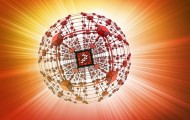当你看到一个塑料袋,可能会首先联想到垃圾,但是Vilas Pol首先想到的是电池。
美国阿贡国家实验室(The Argonne National Laboratory)的研究人员最近发明了一项技术能将塑料袋转化为碳纳米管,成为制造锂离子电池的主要成分之一。从小小的手机,到汽车,锂离子电池已经成为日常生活中必不可少的物品。Vilas Pol称这种转化程序为“升级回收(upcycling)”,因为这些物品经过回收转化以后的价值远远高于它最初的价值。
但Vilas Pol发明的不仅仅是制备纳米管的经济有效的方式,他赋予的更是一种环保的新思路。Vilas Pol 说:“每次走进垃圾回收站,我都能捡到10到15个塑料袋。塑料袋的回收不论在美国还是其他发展中国家都是一个非常严重的问题。人们只是将塑料袋倾倒进垃圾桶,但事实上它们很难被降解。”
早在两年前Vilas Pol就在其一份报告中就已涉及到将塑料袋变废为宝的想法,并提出旧金山的杂货店和药店禁用塑料袋。Vilas Pol 在美国阿贡实验室取得化学科学工程博士后学位,他认为可以发挥自己的专长,寻找一种塑料袋的替代品。
Vilas Pol认真地研究了塑料的属性—由碳、氢、氧组成, 然后得出了利用塑料最好的方式是从中提取碳制成纳米管的结论。因此,他利用醋酸钴作为降解催化剂,将塑料袋投入700摄氏度的高温中直至完全破裂,最后提取碳制备生成含有钴原子的纳米管。
Vilas Pol经过研究发现,从一个塑料袋中提取的碳最终转化成的电力,可以提供一部手机所需的电量。而且回收塑料袋的程序要比传统的纳米管真空制备程序的成本要低得多。 更可喜的是,该技术可以应用于多种类型的塑料,比如, 水壶或者塑料杯,而不仅仅是塑料袋。虽然醋酸钴(催化剂)的成本较高, 但这种物质可以通过回收电池再次获得. 即使提炼过程不采用醋酸钴作为催化剂, 所能提炼的生成物—球体碳仍然可以用作制备打印机油墨。
美国伊利诺伊州回收协会执行官员Mike Mitchell介绍说:“目前,塑料袋的回收再造最常用于制造木塑复合甲板或户外家具。虽然现在有很多商店已经开始提供塑料袋回收服务,但仍有堆积如山的塑料袋得不到有效的处置。这确实是个严重的问题,他们太难回收了。甚至连路边收废品的人都不愿收塑料袋,因为它们太轻了,一阵风就能将它们吹跑。回收产业非常期待针对塑料袋回收的新方案的出现。”
为了能实现这项技术的大规模应用,阿贡实验室的工程师需要设计一个比Vilas Pol在实验室所使用的40cm3的更大的反应堆。Vilas Polf研究塑料袋回收的消息不胫而走,引来很多感兴趣的人给Vilas Pol发邮件表示希望能和他合作共同开发这项技术,Vilas Pol激动地说:“这真是个好消息。”
“升级回收”(UPCYCLING)知多少:
美国伊利诺伊州回收协会执行官员Mike Mitchell对这个名字的解释是:将原本价值很小,甚至没有价值的材料,通过回收转变为有价值的材料的过程。例如,将玻璃厂废弃的玻璃转化为昂贵的台面,或室外家具所使用的木塑复合材料的过程。升级回收具有环境和经济双重价值。 Mike Mitchell说:“与那些有回收价值的东西比起来,难以回收的东西的利润空间会越来越小,甚至变为负值。 回收利用是一个有巨大经济驱动的产业,也是个最基础的环境问题。”
本文英文原文见(southtown), 复材在线编辑部编译,有删改。
The Argonne National Laboratory scholar has developed a new technology that converts the plastic sacks into carbon nanotubes, a component used in lithium-ion batteries that power everything from cell phones to cars. Pol calls the process “upcycling” because the finished product has a much higher value than the initial materials.
Not only is the process he’s created a cheaper way to develop nanotubes, Pol said, it could be an environmental game-changer.
“Many times, when I go to the grocery store, I get 10 or 15 bags,” he said. “The problem (of recycling them) is very serious, not just here but in developing countries. They just dump them in the Dumpster, and they don’t decompose at all.”
The idea to turn plastic bags into something more sprang from a report Pol read two years ago about the bags being banned from San Francisco’s grocery stores and pharmacies. Pol holds a director’s post-doctoral fellowship in chemical sciences and engineering at Argonne, which is near Lemont and is operated by the Department of Energy, and he thought he could use his expertise to find a better alternative to tossing the flimsy carriers.
“My supervisor asked if I could do something with plastics, and I said, ‘It might take time,’ ” Pol said. “He said, ‘Time is no problem.’ ”
Pol considered the properties of plastic, which is composed of carbon, hydrogen and sometimes oxygen, and decided the best use for the bags would be to harvest the carbon to grow nanotubes. Using cobalt acetate as a catalyst, he cooked the bags at 700 degrees Celsius until the plastic broke down, causing the carbon in the plastic to grow as nanotubes on the cobalt particles.
Creating enough nanotubes to power a cell phone takes less than one plastic bag, Pol said, and the process winds up costing less than traditional ways of creating nanotubes, which usually must be created in a vacuum. Better yet, the technology can be applied to several types of plastic, not just plastic bags.
“You can use water bottles or plastic cups,” Pol said.
Although cobalt acetate is relatively expensive, Pol pointed out the material can be recovered when the batteries are recycled. Pol also found that performing the process without cobalt acetate still yields a useful result – carbon spheres that can be used in printer ink.
Right now, plastic bags collected for recycling are used most frequently to create a wood-plastic hybrid used in decking or patio furniture, said Mike Mitchell, executive director of the Illinois Recycling Association. But while more grocery stores around Illinois are starting to offer plastic bag recycling, plenty of bags still wind up in landfills, where they will sit forever.
“They’re definitely an issue,” he said. “They’re hard to recycle. Curbside collectors don’t want them in the curbside program because they’re so lightweight and they get caught in air currents (in recycling centers.) … Then it becomes for residents, ‘Well, what do I do with this?’ ”
New options for plastic bags would be a welcome addition for the recycling industry, Mitchell said.
“It’s the more, the merrier for this type of stuff,” he said.
For the technology to work on a large scale, Argonne will need to work with engineers to design a larger reactor than the 40-cubic-centimeter one Pol uses in his lab. But word of the process is quickly spreading: Pol received an e-mail this week from a Los Angeles-based company eager to partner on the technology.
“It is a big benefit,” Pol said. “The plastic is not going to go away.”
WHAT’S UPCYCLING?
The term refers to the process of turning materials with little or no value into something of much greater value. Mike Mitchell, executive director of the Illinois Recycling Association, said examples of upcycling are growing – from leftover glass at glass plants being turned into expensive tabletops to plastic bags being combined with sawdust to create patio furniture.
For those in the recycling industry, Mitchell said, upcycling holds the allure of both environmental and economic benefits.
“When you compare what some products are worth to the cost of collection, the margin gets slim or negative,” he said. “Recycling is a commodity-driven enterprise. … It’s a very foundational environmental issue, but it’s also a huge economic driver.”
 复材在线原创文章,转载请注明出处!
复材在线原创文章,转载请注明出处!


Leave a Reply
要发表评论,您必须先登录。